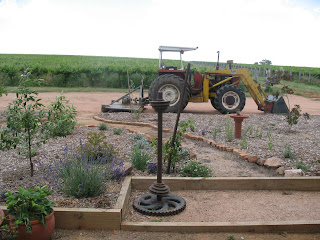OK, so it's not a stone farmhouse in Tuscany, but our shed has proven quite a fine place to live over the past year. I do have a few complaints - the damn dust for one. With the road next to the vineyard unsealed, clouds of red dust roll over us whenever a car goes by. But not too many cars do go by. And one misty morning a herd of cattle moo-ed by and we sat outside with our cups of tea watching the quintessentially Australian scene being played out in our own front yard.
We could get the road sealed, it would certainly cut down the dust. And it would be easier on my poor old Honda.
But we don't want to live on a sealed road, it's so much more interesting with it's rocks and dust and pot holes and kangaroo tracks.
There are plans afoot to renovate the shed. At the moment our bedrooms are upstairs and the bathroom/laundry and kitchen/living areas are downstairs. The middle of the shed (see the roller doors in the photograph) is still a working shed full of farm "stuff" and the other side is the Cellar Door, which we open for wine tasting and sales every weekend. We have decided there is no point building another house on the property, we will just take over the shed and make it a home. After all, the electrics and plumbing are all in place, so why start from scratch?
The Garden.
This spring we established a garden.It was pretty tough going to begin with. The ground around the shed had been severely compacted over years as a drive way and parking area for tractors, trucks and harvesters. We tried to rip the ground buy barely broke the surface, so instead we layered gypsum to break the clay, a few ute loads of compost from a landscape supplier and a truck load of extra river sand and earth to build up levels. The entire area was then covered in a thick layer of mulch. If we keep adding compost, the soil will improve over the next few years. Mulching is absolutely essential for successful gardening in dry Australia. Well, mostly dry. As luck would have it we just experienced our wettest summer in decades, so many of our young drought hardy plants have turned up their toes in the water logged clay ground. I will replant as soon as the weather cools down.
This spring we established a garden.It was pretty tough going to begin with. The ground around the shed had been severely compacted over years as a drive way and parking area for tractors, trucks and harvesters. We tried to rip the ground buy barely broke the surface, so instead we layered gypsum to break the clay, a few ute loads of compost from a landscape supplier and a truck load of extra river sand and earth to build up levels. The entire area was then covered in a thick layer of mulch. If we keep adding compost, the soil will improve over the next few years. Mulching is absolutely essential for successful gardening in dry Australia. Well, mostly dry. As luck would have it we just experienced our wettest summer in decades, so many of our young drought hardy plants have turned up their toes in the water logged clay ground. I will replant as soon as the weather cools down.
I want the garden to be a shady haven in our long hot summers. I like controlled chaos in a garden - no neat borders, box hedges or boring roses on sticks. I prefer a garden to be full, over-grown, edging on wild. Mostly green with splashes of colour here and there. I like trees to grow in unusual forms with limbs overhanging paths or bent into bonsai-like shapes.
Not for me those perfectly formed straight trunked trees sold in nurseries. The botanical equivalent of "little boxes on the hillside".
I've learnt over the past ten years what grows best out here in central NSW. Favourite plants, often repeated or planted en masse, include rosemary, pennisetum rubrum, Russian sage, silver wormwood, sedum, seaside daisy, artichoke and lavender (French or English, not Spanish -too prissy.) Many of these plants can be divided and propagated at home, saving lots of money on landscaping. Australian natives such as emu bush, wattles and hakea also feature.
For shade, we have planted a fast growing White Cedar (also known as Persian Lilac), a Chinese Pistachio, a Japanese flowering plum, a crab apple, an ash and a black mulberry. And I could never have a garden without herbs. Instant gratification and useful as well, we scatter herbs throughout the garden in a roughly permacultural kind of way. We have thyme, sage, rosemary, flat leaf parsley, lemongrass, lemon verbena, bay, chives, dill, basil, rocket, garlic and mint. I have given up on coriander as it always bolts to seed.
Last night, half the ingredients that made up our dinner came from our garden. Home made pasta using our own eggs, our own garlic, tomatoes, basil and sage. How much better life is with a garden!




'Tis indeed dusty!
ReplyDeleteas you go and replace as you remove. Bear in mind the more joints that you make the more chance you will have of having a leak so keep the joints to a minimum. water heater installation
ReplyDelete